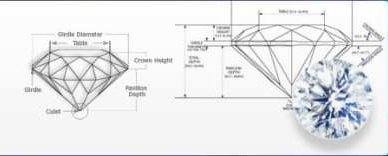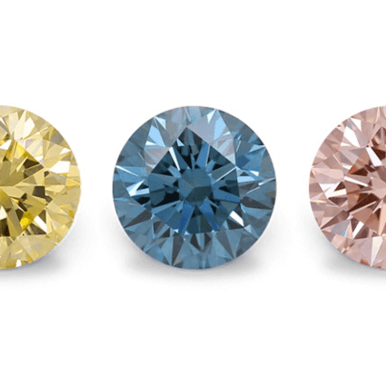Largest Lab-Grown Diamonds
Largest Lab-Grown Diamonds: The Potential For Growth
Is the 300 carat lab-grown diamond possible? We think the answer is yes.
Lab-grown diamonds are the symbiosis of human achievement in technology and the lessons that we learned from nature. And while the public truly found out about them only a few years ago, they’ve been here for over half a century. Labrilliante looks at the history of man-made diamonds and the way they grew larger as the progress advanced.

In the 1950s, General Electric became the first company to produce a set of manufactured diamonds. They created the technology called belt press which was similar in functionality to the modern HPHT process. By applying high pressure and temperature they were able to use metals as the growth catalyst to help form a diamond out of graphite. The first diamonds were small and had a very bad quality, so they couldn’t be used for jewelry manufacturing. However, they were great for the industrial use, which they started to be applied for.
Order a diamond of your desired weight!
As the technology improved, so did the product. First gem-quality lab diamonds appeared in the 1970s with the stronger research and worldwide introduction of HPHT and CVD methods. The 25 carat rough diamond was produced by the De Beers Diamond Research Laboratory with HPHT for scientific purposes.
Manufactured gems became commercially available a decade later, but the demand and public’s interest for man-made diamonds were not as strong until 2014, when the industry truly emerged. Over the years, scientific research across the globe allowed lab-created stones to exceed mined diamonds in carat weight and quality. When more and more big-name companies, such as De Beers, Pandora, Signet, and others, started to use manufactured gems, they legitimized them for the industry and the consumers.

Today, both CVD and HPHT methods are globally applied to grow diamonds. HPHT reproduces natural conditions, with high pressure and high temperature helps to turn carbon atoms of graphite into a rough. This method is quite expensive and complex and usually results in diamonds that are bigger and have better quality. On the other hand, the CVD process uses almost no pressure. Manufacturers use a vacuum chamber, where carbon-rich gas vaporizes into a carbon plasma that builds into a diamond layer by layer. It usually takes less time and helps to create bigger volumes of most demandable gems that have 1 to 3 carat weight and near colorless grade. However, recent developments allowed for much larger diamonds grown with the CVD method.
2014
The largest lab diamond, a radiant cut, is produced using HPHT, which is later graded by IGI having 5.11 carat weight, J color and SI1 clarity.

2015
The record is surpassed by production of the 10.02 carat Emerald cut with E color and VS1 clarity with HPHT method. A 32.26 carat lab-grown rough is grown, the biggest at that time.
2016
HPHT process allows us to create the biggest fancy colored lab diamond: an as-grown Fancy Deep Blue Emerald cut that has 5.03 carat weight. At the same time the largest CVD-grown diamond graded at GIA as 5.19 carat Cushion cut.
2017
The 6.28 carat Cushion cut with J color and VS2 clarity becomes the biggest man-made diamond manufactured in the USA. At the same time, the laboratory in Germany creates the biggest industrial diamond with the CVD method. It has a disc shape and the weight of 155 carat, and is not suitable for jewelry use.

2018
A record is broken with a 15.32 carat Cushion cut that has G color and SI2 clarity. It was grown with the HPHT method. At the same time, the biggest Pink lab diamond is created with CVD process and irradiation: a 5.01 carat Fancy Intense Orangy Pink Cushion cut with I1 clarity. The largest HPHT-grown Fancy Blue diamond is also announced having 10.08 carat weight. A 9.04 carat CVD Round Brilliant cut that has I color and VS2 clarity surpasses the record for lab diamonds grown in the USA.

2019
An as-grown Fancy Vivid Orangy Yellow Cushion cut with VS2 clarity grown in an HPHT-press sets another record in size: it weighs 20.23 carat.

2020
The heaviest 115 carat HPHT rough diamond is produced. The largest CVD-grown diamond is a 12.75 carat Round Brilliant cut which is graded by IGI.
2021
A 14.60 carat Emerald cut sets a new record for CVD method.

2022
This is a year of breaking the records. The largest HPHT rough diamonds are reported: 150.42-carat blue one and a 141.58-carat grayish one. CVD method allows for new records in polished goods. At the start of the year, a 16.41-carat G VVS2 Princess cut is graded by GIA.
During the JCK new CVD-grown behemoths are displayed: the 15.16-carat Pear Rose cut, the 20.24-carat Emerald cut, and the 27.27-carat Marquise Rose cut. The main attraction, however, is the new record-holder which is the 30.18-carat Emerald cut, also grown with CVD method.
Conclusions
Growing technology advances with every year and the plans for 200 carats rough are no longer a dream. Looking at the timeline, we can only imagine how big lab-grown diamonds will become in a few years. And the very best thing is that the demand for such big diamonds is there. LaBrilliante is the leader among the manufacturers and we’re constantly improving our technology. Our goal for the nearest future is to create an HPHT rough diamond with 200 or even 300 carat weight. We believe that there is an immense potential in the larger gemstones and we’re ready to present them to you.














